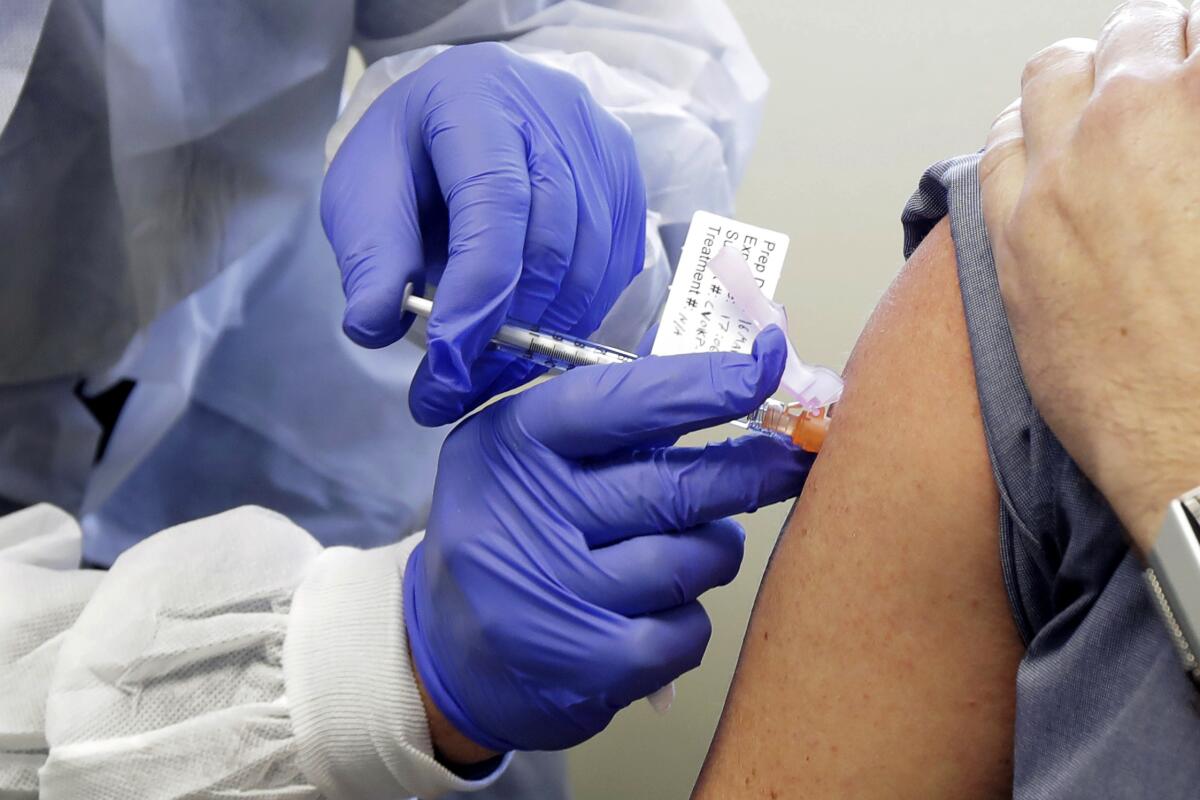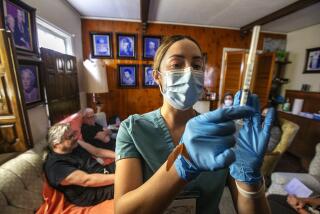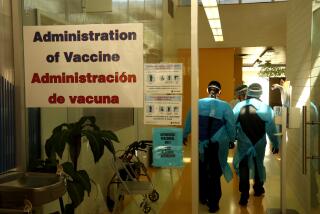Its freezer kaput, this NorCal hospital had two hours to give out 600 vaccine shots

SACRAMENTO — About the time Gov. Gavin Newsom took to Facebook on Monday to lament the pace of vaccine distribution statewide, one Northern California hospital was injecting local residents at a furious pace — providing an unintentional road map for how a mass inoculation program could work.
At 11:35 on Monday morning, senior staff at Adventist Health Ukiah Valley Medical Center in Mendocino County were holding their first 2021 executive meeting when the hospital pharmacist interrupted: The compressor on a freezer storing 830 doses of the Moderna COVID-19 vaccine had stopped working hours earlier, and the alarm meant to guard against such failure had failed.
The doses were quickly thawing.
“It was not how my day was planned,” said Adventist spokeswoman Cici Winiger, who was in the executive meeting. “At that point it was all hands on deck, drop everything.”
The Moderna vaccine is shipped and stored at frozen temperatures, and stays stable up to 8 degrees Celsius in a regular refrigerator for up to 30 days. But once it reaches room temperature, as it did in the Adventist freezer, it must be used within 12 hours. By the time the freezer problem was discovered, the vials had been creeping toward warm for some time.
Medical staff estimated they had two hours to use them before they would no longer be viable.
With the minutes ticking down, the medical team made the decision that the goal would be to inject every dose, regardless of state guidelines. The medical team believed that “the more people we vaccinate just brings us closer to herd immunity,” Winiger said.
Winiger got on the phone, trying to give the shots first to those on the priority lists. One local elder care facility took 40 doses for staff, and the hospital’s chief medical officer drove them to the facility himself.
About 200 doses belong to the county and were being stored by the hospital. Winiger said those doses were returned to the county. The county in turn gave 100 doses to the city of Ukiah, county Chief Executive Carmel J. Angelo said.
Lt. John Bednar, who helps run the county jail, said his facility received 97 of those county doses about 1 p.m. The jail has been experiencing an outbreak, with about three dozen inmates out of 250 currently positive, he said. About a dozen staff have also fallen ill with the virus.
Faced with only an hour to use the shots, sheriff’s officials decided to administer them to staff and front-line personnel because they didn’t think there was enough time to gain consent and organize a safe protocol for inmates. Four county medical staff began giving the shots, Bednar said.
“I was like, ‘Oh, boy, let’s get going,’” Bednar said, when the shots first arrived. “I think it went as well as it could.”
An additional 100 doses hit the fire department about 12:15 p.m., Fire Chief Doug Hutchison said. At first, garbled information he received through phone calls left him fearing all 800 doses were coming his way, leaving him thinking, “There is no way,” he said. His full-time staff of 16 had already been promised to help with other clinics.
Hutchison headed to a city conference center, and his remaining crew “began giving shots as fast as we could sit people down and roll up their sleeve,” he said. Their syringes went into the arms of police, essential city staff and firefighters — including Hutchison, who had declined earlier offerings of the vaccine to make sure his staff got it first.
“I was trying to make sure all my people got shots before I did,” he said.
Ukiah is hardly the only community nationwide that has encountered temperature problems in distributing a COVID-19 vaccine. Last month, New Mexico reported it had lost 75 doses of Pfizer’s vaccine because of potential overheating during delivery to a hospital, and Texas reported that a “temperature excursion” forced it to set aside 4,300 doses of the Moderna vaccine, later replaced by the federal government.
On Christmas Day in Connecticut, a power outage caused by a winter storm forced medical providers to launch their own Operation Warp Speed to distribute hundreds of doses of the Moderna vaccine before they became useless.
Despite such incidents, the main challenges in mass inoculations have to do with logistical and bureaucratic complications, lack of a centralized state or federal system for distributing the vaccine, and public uncertainty about the safety of the vaccines, despite successful clinical trials last year.
California received about 1.3 million doses, but only about 454,000 people have received the vaccine, Gov. Gavin Newsom said Monday.
In Mendocino County, Bednar, the sheriff’s lieutenant, was one of those who received the initial dose Monday, though he isn’t yet sure how he feels about it.
“It’s one of those things where I was a little hesitant at first because it’s a new vaccine,” he said. “But I have family that is older, and it’s better that I get it than possibly risk their safety.”
Even as the shots were being delivered to the jail, a big-rig accident on one of the main highways cut the hospital off from its sister facility about 20 minutes away, Winiger said, making it impossible to reach. Ukiah, a town of about 20,000 surrounded by state and national forest, has a population spread through its rural and often difficult-to-navigate territory, creating a daunting challenge to quickly deliver the doses to remote areas.
The Adventist staff turned instead to the local community, with about 600 shots remaining.
First, they sent a text asking every available medical professional to turn out at one of four sites to give the vaccines and monitor those who took them.
“We had nurses, pharmacists, physicians, even those that are not part of the hospital, coming to help,” said Judson Howe, president for Adventist Health in Mendocino County. “It was all hands on deck and a true community effort.”
Then hospital staff blasted out a text to employees letting people know that anyone who showed up could have the shot. “We just wanted to make sure none of this goes to waste,” Winiger said.
By noon, within 15 minutes after learning of the freezer failure, shots were being administered at all four sites. Lines began to form as word spread and some staff was siphoned off for crowd control. At the site Winiger ran, about 30 people were turned away after the doses ran out. At the main site near the hospital, she estimates about 120 people left without the shot.
But by the two-hour deadline, every dose had found a patient, Winiger said.
By Tuesday morning, an unexpected problem arose: Conspiracy theories began circulating in the small community alleging that that the broken freezer was no mishap, but part of a plot to give the vaccine to preferred people.
Some said a pharmacist had purposefully disconnected the power, then took the doses to his church to give to parishioners. Another theory suggested hospital leadership staged it as a secret way of giving shots to friends and family first. Some community members were upset that more had not been done to reach those meant to be in the first tier of distribution.
Others worried that the hospital wasn’t planning on giving a necessary second shot to those who received the first dose Monday — though Winiger said contact information had been collected from all recipients and they would have priority for the second dose.
“I’ve never dealt with a conspiracy theory up close and personal,” said one person involved in the vaccine distribution, who asked to remain anonymous for fear of retaliation. “It never occurred to me that this could get out of hand so quickly.”
The person, a longtime resident of Ukiah, describes the local population as “old hippies and descendants of very conservative farmers,” who share outrage about special treatment for any particular group.
“I think it ties into all the craziness that legitimately exists about people who get special handling,” the person said.
Despite the blowback, Winiger described the effort as “heroic,” with dozens of medical staff turning out to volunteer within minutes and a quick decision to split into four clinics that kept crowds at controllable numbers.
In his briefing Monday, Newsom also mentioned the need not to waste doses.
“We have plenty of people that want to take that shot,” he said, “and the key is to make sure that, while we are enforcing the rules of the road, we’re aren’t enforcing against just common sense and the energy of someone who says: ‘Look, I don’t want to waste this dose. Why don’t I get it to someone?’”
Although it could take some time to know the effectiveness of Monday’s mass inoculations, the impromptu effort, Winiger said, may prove to be a lesson on how the state could more quickly and efficiently administer vaccines.
Hopefully in less stressful circumstances.
“It’s just amazing to go toward one goal and get it done,” Winiger said. “I was just thinking in my head, can you imagine if we had more time to do this? If this is how we do a massive vaccination later, we are golden. We can do this.”
More to Read
Sign up for Essential California
The most important California stories and recommendations in your inbox every morning.
You may occasionally receive promotional content from the Los Angeles Times.












